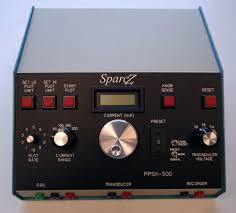PPSX-500 SERVOVALVE DRIVER

Let’s review some of the features that make the PPSX-500 SERVOVALVE and Torque Motor DRIVER unique:
AUTORAMPING
~ The output current can be set to ramp automatically between any two set endpoints within the range of +/- 50mA to +/- 500mA – A feature very handy when testing servovalves. Additionally, you may set up to 48 preset points for current ranges. If the range of your valve is 0 to 100 milliamps, you may want to check its performance at 0, 25, 50 and 100 mA. Rather than dialing in those numbers each time, they can be programmed in as set points and you can simply jump from point to point. These settings are saved in a non-volatile memory so there is no need to re-set them each time you use the unit.
PRECISION
~ Like most of the CC supplies out there, the PPSX-500 is digitally controlled; however, while most other units are 12 bit resolution the PPSX-500 offers 16 bit resolution. This provides 64 times the accuracy of other, general purpose products. As you may be aware, when ramping in the low ranges, 12 bit units have a “staircasing” effect due to poor resolution. This unit offers much smoother ramping.
HARDENED DESIGN AND CONSTRUCTION
~ Virtually all of the constant current power supplies assume a pristine laboratory environment. Our PPSX-500 SERVOVALVE and Torque Motor DRIVER has been designed to operate in an industrial setting, where conditions may be less than favorable. It is rugged and durable. Sure, our product will work in a clean room, but you can also take it out to the production floor without fear of damaging it. Now that’s a great value!
BUILT-IN PLOTTER INTERFACE
~ When doing servovalve testing, you are usually required to generate a plot of current into the valve vs. pressure or flow out of the valve. This is typically done on a chart recorder or some data acquisition system. Our power supply has a signal out that is proportional to current to the valve thus facilitating the test requirements.
AUXILIARY INPUT PORT
~ Our PPSX-500 SERVOVALVE DRIVER has an auxiliary input that will allow the output current to be dictated by some external source such as a function generator or a computerized test system. For example, if needed, you could generate a CC sine wave or repetitive ramp cycle.
